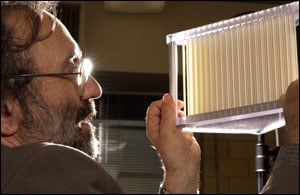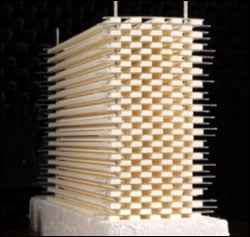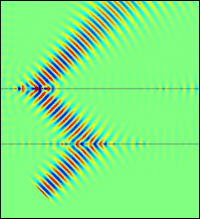Novel "left-handed" materials (LHMs) with unusual properties could improve devices in communications, electronics, optics and medicine, said Information Society Technologies (IST), a European Union research initiative. Scientists who pioneered this exciting new field worked to improve the new materials in the IST's Development and Analysis of Left-Handed Materials (DALHM) project, which won the prestigious EU Descartes Prize for Excellence in Science last year.

Costas Soukoulis examines one of the photonic crystals that were constructed to observe negative refraction and superlensing in the microwave region of the electromagnetic spectrum. (Photo courtesy Foundation for Research and Technology-Hellas)
Their work could vastly improve magnetic resonance imaging (MRI) scanning, and it has enabled subwavelength focusing, resulting in higher resolutions for optical imaging and nanolithography. It has already led to the development of a superlens, an optical lens capable of vastly improved microscopic resolution. Subwavelength nano-light sources could be used for photonic applications and molecular detection, which could result in a new type of smaller antenna that uses less power, potentially enabling 'chip-to-chip' communication using microscopic antennas abd reducing the energy required for high-power lasers. In sum, in could have applications in almost any field that exploits electromagnetic radiation, the IST said.
With funding from the European Commission's Future and Emerging Technologies (FET) initiative, part of the IST program, the DALHM project sought to understand and extend the unusual electrical, magnetic and refractive properties of LHMs. Left-handed, or negative-index materials, once appeared impossible because they seem to break fundamental physical laws and no naturally occurring materials have a negative refractive index.

This photonic crystal has a negative index of refraction equal to -1, providing excellent subwavelength resolution. (Photo courtesy Foundation for Research and Technology-Hellas)
The term "left-handed material" comes from electromagnetism. When electromagnetic radiation (EMR) -- from light to microwaves -- moves from one medium, like air, to a second medium, like water, it bends or refracts by a positive angle so it emerges to the right of the incident beam in proportion to the refractive index of the second medium. This is Snell's Law. But when EMR encounters a left-handed material, it bends by a negative angle so it emerges on the left side of the incident beam. This is a negative refractive index. Originally, scientists believed this contradicted Snell's law, but further work showed the law was maintained, albeit with a negative value.
"Negative refraction was such a revolutionary result, that at the beginning there were many objections based on the alleged violations of causality, of the conservation of momentum and of Fermat's principle," said DALHM's project coordinator, Costas Soukoulis, a professor of physics at Iowa State University and a researcher at the Foundation for Research and Technology-Hellas in Crete. Soukoulis is one of the LHM pioneers.
"Our collaboration convincingly showed that all these objections were not valid," Soukoulis said. "Having mastered the intricacies and complications of LHMs, we moved in the direction of developing modified designs that were easier to fabricate, more compact and amenable to a wealth of possible applications."

Metamaterials structures such as these SRRs at left are amenable to manufacture by common planar lithography. They have a magnetic response perpendicular to the plane, which is difficult to detect by direct incidence measurements. The structures shown in the center and at right make use of multilayer processing and have been used to fabricate metamaterials that give both negative e and m, as well as n, for perpendicular propagation. (Image courtesy Foundation for Research and Technology-Hellas)
A left-handed material creates all sorts of unusual phenomena, Soukoulis said. "It breaks the diffraction limit, a limit that means the maximum resolution attainable in a microscope is the wavelength of incident light. It reverses the Doppler effect, which governs the apparent change in wavelength of the light (or radiation) from a source due to its relative motion. It could potentially create zero reflectance, where no waves bounce back when they encounter an object. All these effects arise from the electrical, magnetic and refractive novelties of LHM and promise a range of new devices."

An electromagnetic wave is hitting a slab of negative index material. Note that it bends in opposite direction from that of a positive index material. This special property of the negative index materials can be used to fabricate flat lenses.(Umage courtesy Foundation for Research and Technology-Hellas)
The DALHM project created materials that extended the range of frequencies that can be exploited, from radio frequencies in the MHz to the near-infrared in the THz. The work could lead to LHMs in the visible spectrum.
The research team, which also included Ekmel Ozbay of Turkey's Bilkent University, improved simulation and modeling tools to study increasingly complex metamaterial structures, developed and tested new structures and demonstrated that photonic crystals could work like an LHM.
It identified the telecommunications and imaging fields as areas with the greatest commercial applications. The team members hold more than 12 patents in the field, with another four pending or due for submission.
What happens next?
"We have been instrumental in creating and developing a new revolutionary field, which extends the realm of electromagnetism and opens up exciting technological applications," Soukolis said. "In the future, the big challenge is to extend the NIM band from the few GHz (superhigh frequency of extremely high frequency) range, either to lower frequencies with applications in the MRI field or to higher telecommunication or even optical frequencies."
For more information, visit: www.iesl.forth.gr/research/tccc/photonic/index.asp